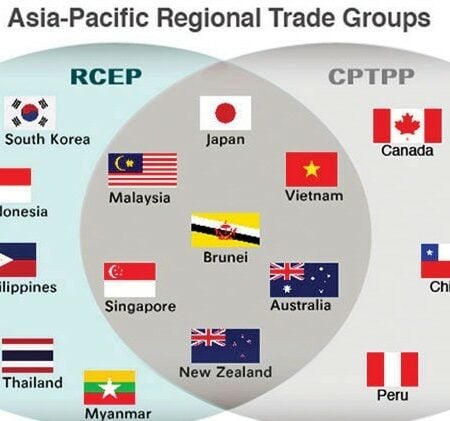
How a robust middle class ensures a stable and prosperous future for Vietnam
Why the middle class matters
The history of the world consistently demonstrates that when power and wealth become overly concentrated in hands of a few, it leads to instability and conflict. Whereas when power and wealth is broadly distributed, especially including a robust middle class, it contributes to stability and prosperity. In Walter Scheidel’s book The Great Leveler, he demonstrates that throughout history, large disparities between the wealthy and the poor are unsustainable and lead to collapse, and subsequently a redistribution of assets.
In the aftermath of World War II, Allied Occupation Policies in Japan were designed to enable the rise of a middle class to prevent the rise of fascism. The Supreme Commander for the Allied Powers oversaw land reforms, dissolved the powerful zaibatsu conglomerates, and enacted progressive labor laws that empowered workers. By 1950, roughly 4.5 to 5 million farm households (who didn’t previously own land) had purchased more than 2 million hectares of land under the reform program. The proportion of owner-cultivated land rose from about 55% in 1946 to over 90% by the early 1950s, effectively creating a nation of small-scale owner-farmers. Before the reforms, many tenant farmers had no land ownership at all; post-reform, nearly all farmland was directly cultivated by its owners. The transition to widespread small-plot ownership has been credited by development economists for helping stabilize rural Japan and laying the foundation for its high-growth decades to follow.
Another example is Vietnam before and after its independence from French colonial rule. Under French colonial administration, a small group of large landowners had extensive land holdings. Peasants typically rented or sharecropped this land under arduous conditions. Under Ho Chi Minh’s leadership, the Vietnamese declared independence in September 1945 and a series of land reforms were launched, initially in the North, and later in the South after the country was reunited in 1975. Land was reclaimed from large landlords and wealthy farmers, then redistributed to poor and landless peasants. According to some historical accounts, as much as 70% of farmland in the north changed hands during the 1950s. As a result, its currently estimated that 8-9 million families in Vietnam (around 1/3 of families) have Land Use Rights (similar to ownership) of small farms. The typical size of those farms ranges from 0.3 to 1.0 hectares.
For the remainder of this article, I will explore some critical contributing factors to a robust middle class, and therefore the necessary ingredients for economic stability and prosperity. Vietnam’s strong position in these areas indicates that Vietnam is exceptionally well positioned to grow its middle class, and therefore has a stable and robust economic future ahead.
Widespread home ownership
Peruvian economist Hernando de Soto, in his book The Mystery of Capital, argues that widespread ownership of real estate, and clear property rights which provide the ability to own with clear title, transfer, or use real estate as collateral for loans, are critical for economic development and the emergence of a robust middle class.
90% of Vietnamese households own their own home (while most don’t even have a mortgage). This places Vietnam among the highest in the world, similar to China (also around 90%) and Singapore (88%). In general, Asia has higher levels of home ownership than the rest of the world. By comparison, the world average is 65% and in the United States it is 66%.
We can see in the table below that the countries with the highest rates of home ownership are correlated with the countries with the highest rate of growth of the middle class over the last 10 years.

Educational outperformance
Access to quality education is a critical foundation for a robust middle class. The Program for International Student Assessment (PISA) is an international survey organized by the OECD to evaluate education systems worldwide by testing the skills and knowledge of 15-year-old students in reading, mathematics, and science. The 2022 PISA assessment covered 81 countries and territories. Using a logarithmic trend line, there is a very strong correlation between PISA scores and per capita GDP across those 81 countries (R2=64.7%). Interestingly, East Asian countries are all positive outliers with educational outcomes beyond what is predicted based on their current per capita GDP levels, but Vietnam is the biggest outlier among them. In other words, Vietnam’s current educational outcomes implies it should have a per capita GDP around $35,000 rather than the current level of $4,860.
This indicates that East Asian countries, especially Vietnam, will continue to see economic benefits from their strong commitment to education, especially STEM, which is common throughout East Asia.

Inclusive institutions
In the book Why Nations Fail by 2024 Nobel prize winning authors Daron Acemoglu & James A. Robinson, they demonstrate that nations thrive when they have “inclusive” institutions – those that broadly protect property rights, foster innovation and entrepreneurship, and provide equal access to basic rights and government services. In such systems, public institutions ensure that small businesses can thrive and that no single group monopolizes economic opportunities. Healthcare, education and economic opportunities are available to all regardless of ethnicity, social status, etc. This inclusivity leads to a growing middle class and relative social stability.
On the other hand, countries with “extractive” institutions tend to concentrate power in the hands of a small elite, such as oligarchs, a particular ethnic group or even a single family. These elites design policies that “extract” wealth and resources from the majority, leaving little room for upward mobility or broad-based economic growth. Over time, these extractive regimes discourage competition and stifle innovation, resulting in smaller, more vulnerable middle classes and, frequently, political and social instability.
Since the 1980s, Vietnam has pursued highly inclusive policies to provide:
- Education: Widespread access to education, leading to exceptionally high PISA scores and a 96% adult literacy rate in Vietnam.
- Healthcare: Through universal health insurance, robust local health centers, and targeted public investment in facilities and preventive care, Vietnam has built a healthcare system that delivers a wide base of affordable services. Its notable also that Vietnam has one of the world’s lowest obesity rates , at less than 2%, which perhaps helps to reduce the burden on the healthcare system.
- Electricity: In the early 1990s, an estimated 14%–20% of rural households in Vietnam had electricity. By 2020, the World Bank reported over 99% electrification nationwide.
- Small businesses: Small and medium-sized enterprises (SMEs) account for over 95% of total enterprises in Vietnam. According to the General Statistics Office (GSO), Vietnam regularly sees over 100,000 newly registered companies per year. Unlike some other economies in which a handful of families have been controlling a few massive conglomerates for the last 50-100 years, Vietnam is characterized by a much more fragmented and widely distributed private sector.
These factors have likely contributed to Vietnam’s poverty rate falling from around 50% in the early 1990s to under 6% in 2021 according to the world bank.
Modest debt levels
Vietnam enjoys modest levels of national debt and household debt as a percentage of GDP. While national debt will ultimately impact issues such as inflation and the value of the currency, household debt levels can have a big impact on the ability of families to emerge into the middle class or stay in the middle class. For example, in the United States currently, the high burden of student debt and medical debt has pushed many middle class families into bankruptcy and contributed to a shrinking middle class.
Vietnam’s current low levels of household debt, at around 25% of GDP, are unlikely to impede the development of its middle class.

The result: A robust and fast-growing middle class
The impact of all of this is that Vietnam’s middle class has been growing steadily since the economic reforms of the 1980s. But it really stands out over the last 10 years is that Vietnam is the country in Asia with both the highest rate of growth of households in the middle class and also growth in the spending power of those middle class households.

Taken together, Vietnam’s widespread home ownership, strong educational performance, and inclusive institutions have created a supportive environment for small businesses and upward mobility, fueling rapid growth in its middle class. Low levels of household debt and far-reaching public investments – whether in healthcare, electricity, or infrastructure – further cement this progress by broadening economic opportunity and shielding households from severe financial shocks. As Vietnam continues to leverage its high literacy rate, strong STEM focus, and policies that encourage both domestic enterprise and foreign investment, its middle class will not only remain stable but expand – driving the country toward sustained prosperity and social stability in the decades ahead.
—
About the author: Chris Freund is the founder and Managing Partner of Mekong Capital, Vietnam’s first Private Equity firm, which was established in 2001 and had made more than 45 private equity investments in Vietnamese companies. Vietnam is home to Chris, where he has lived for more than 27 years, starting in 1994.






Leave a Reply